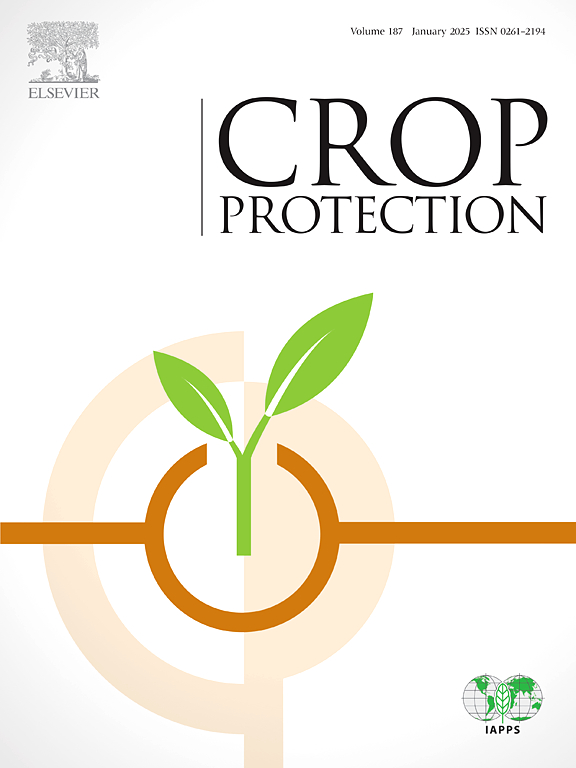IF 2.5
2区 农林科学
Q1 AGRONOMY
引用次数: 0
摘要
来自Annona(Annonaceae)物种的异位化学物质可作为一种可持续的工具,用于控制草莓的主要害虫欧洲胡椒蛾(Duponchelia fovealis)。在这项研究中,我们评估了由粘膜胭脂虫和茜草胭脂虫的乙醇种子提取物(ESA)制备的水乳剂对欧洲胡椒夜蛾的繁殖参数及其相关天敌 Chrysoperla externa 幼虫的亚致死效应(LC25)。我们使用了以胭脂虫素为基础的植物杀虫剂(Anosom® 1 EC)和以氯虫苯甲酰胺为基础的合成杀虫剂(Pirate®)作为阳性对照。此外,我们还通过组织学评估的方法,评估了对交尾蝇幼虫的排泄系统和神经系统造成的损害。从A. 粘膜制备的ESA(LC25)的毒性低于Anosom® 1 EC。雄性个体在接触 Anosom® 1 EC 后寿命受到抑制,而使用 A. sylvatica ESA 处理的雄性个体寿命最长。当雄性暴露于ESA A. mucosa时,观察到卵的数量大大减少。相反,雄虫接触 Pirate® 时,卵的数量有所增加。用 ESA A. mucosa 或 Anosom® 1 EC 处理幼虫时,未观察到幼虫回避,而用 ESA A. sylvatica 或 Pirate® 处理幼虫时,幼虫被吸引。对于 C. externa,ESA 会导致幼虫回避,但 Anosom® 1 EC 不会造成行为干扰,而 Pirate® 则会吸引幼虫。用粘虫和蚜虫的ESA(LC25)处理幼虫器官时,可观察到组织学上的改变。我们的研究结果证明,即使在低浓度条件下,ESA 也有潜力用于 D. fovealis 的综合治理。本文章由计算机程序翻译,如有差异,请以英文原文为准。
Annona spp. derivatives: Sublethal effects and behavioral interference on the European pepper moth and an associated predator
Allelochemicals from Annona (Annonaceae) species can be a sustainable tool in the control of the European pepper moth, Duponchelia fovealis, a key pest of strawberry. In this study, we assessed the sublethal (LC25) effects of aqueous emulsions prepared from ethanolic seed extracts (ESA) of Annona mucosa and Annona sylvatica on reproductive parameters of D. fovealis and on its associated predator, Chrysoperla externa larvae. An annonin-based botanical insecticide (Anosom® 1 EC) and a chlorfenapyr-based synthetic insecticide (Pirate®) were used as positive controls. In addition, we evaluated the damages to the excretory and nervous systems of D. fovealis larvae by means of histological assessments. The toxicity of ESA prepared from A. mucosa (LC25) was lower than that of Anosom® 1 EC. Male longevity was inhibited when couples were exposed to Anosom® 1 EC, while males treated with ESA A. sylvatica showed the highest longevity. When males were exposed to ESA A. mucosa, a considerable reduction in the number of eggs was observed. In contrast, the number of eggs increased when males were exposed to Pirate®. No avoidance was observed when larvae were treated with ESA A. mucosa or Anosom® 1 EC, whereas for ESA A. sylvatica or Pirate® larvae were attracted. Concerning C. externa, ESA caused avoidance, but no behavioral interference was observed for Anosom® 1 EC, while attraction occurred for Pirate®. Histological alterations in larvae organs were observed when treated with ESA (LC25) from A. mucosa and A. sylvatica. Our results proved the potential of ESA, even at low concentrations, in the framework of D. fovealis integrated management.
求助全文
通过发布文献求助,成功后即可免费获取论文全文。
去求助
来源期刊

Crop Protection
农林科学-农艺学
CiteScore
6.10
自引率
3.60%
发文量
200
审稿时长
29 days
期刊介绍:
The Editors of Crop Protection especially welcome papers describing an interdisciplinary approach showing how different control strategies can be integrated into practical pest management programs, covering high and low input agricultural systems worldwide. Crop Protection particularly emphasizes the practical aspects of control in the field and for protected crops, and includes work which may lead in the near future to more effective control. The journal does not duplicate the many existing excellent biological science journals, which deal mainly with the more fundamental aspects of plant pathology, applied zoology and weed science. Crop Protection covers all practical aspects of pest, disease and weed control, including the following topics:
-Abiotic damage-
Agronomic control methods-
Assessment of pest and disease damage-
Molecular methods for the detection and assessment of pests and diseases-
Biological control-
Biorational pesticides-
Control of animal pests of world crops-
Control of diseases of crop plants caused by microorganisms-
Control of weeds and integrated management-
Economic considerations-
Effects of plant growth regulators-
Environmental benefits of reduced pesticide use-
Environmental effects of pesticides-
Epidemiology of pests and diseases in relation to control-
GM Crops, and genetic engineering applications-
Importance and control of postharvest crop losses-
Integrated control-
Interrelationships and compatibility among different control strategies-
Invasive species as they relate to implications for crop protection-
Pesticide application methods-
Pest management-
Phytobiomes for pest and disease control-
Resistance management-
Sampling and monitoring schemes for diseases, nematodes, pests and weeds.
 求助内容:
求助内容: 应助结果提醒方式:
应助结果提醒方式:


